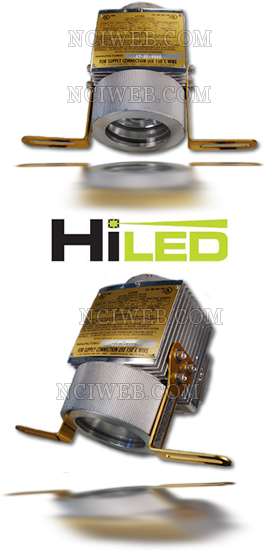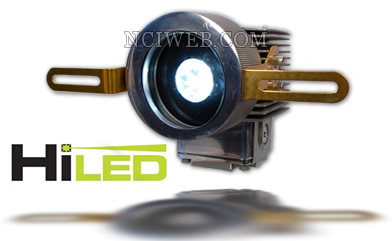Series SLEX-100 HI-LED & REX-100 HI-LED |
|||||||||||||||||||||||||||||||||||||||||||||
|
Explosion-proof, UL-844 and C-UL/CSA C22.2 No. 137 listed, electric lighting fixtures are used in hazardous (classified) locations, lights for single port viewing have been designed to meet the needs of our customers who require lighting and viewing through a single sightglass. Designated the SLEX-100 HI-LED & REX-100 HI-LED, both models use HI-LED technology to provide bright, glare free illumination of the interior of vessels, tanks, hopper, silos, mixers and other normally closed containers in hazardous locations requiring explosion-proof equipment. The REX-100 HI-LED is provided with a highly polished internal reflector which increases the illumination intensity. The explosion-proof light can be supplied mounted to the upper flange of our circular sight glass to form a complete light/sight glass assembly. The light fixture can also be mounted to our smaller viewing diameter sight glasses such as 3-1/4" and 4" to form illumination ports. The illumination port used in conjunction with a standard sight glass offers the user many options. A typical option would be the use of a video or TV camera on the free sight glass while the illumination port provides the necessary lighting. The explosion-proof light fixtures can also be easily mounted to existing sight glasses by means of the slotted brackets provided. Standard Features:
|
|||||||||||||||||||||||||||||||||||||||||||||
| HI-LED Lighting Series: | |||||||||||||||||||||||||||||||||||||||||||||
|
Hi-LED fixtures also reduce costs by making maintenance easier. The extended lamp life of Hi-LED Series reduces the inconvenience and nuisance factor of replacing burned out lamps, especially when they are difficult to access. The Hi-LED fixture housing does not transmit heat into the sight glass or vessel, eliminating the negative effect heat may have on some applications. Hi-LED fixtures emit uniform, bright, white light thatoffers an excellent view of the vessel, making them ideal for use with video camera monitoring systems. High Intensity LED Light Engine Features:
Custom Designed, Energy Efficient, Compact Hi-LED™ LED Array Meets LM80 Energy Star Standards Hi-LED Series lighting is not an “off-the-shelf” LED bulb. It was custom designed for Papailias to include features that save energy, provide uniform light, and extend the life of the lamp to reduce overall operating costs. The heart of the unit, the LED array, has been LM80 tested and is approved for the Energy Star program. State-of-the-art optics control the light in a specific uniform pattern, eliminating the hot spots and yellow tint that halogen bulbs produce.
|
|||||||||||||||||||||||||||||||||||||||||||||
| MODELS AND SPECIFICATIONS | |||||||||||||||||||||||||||||||||||||||||||||
|
|||||||||||||||||||||||||||||||||||||||||||||
| * Operating temperatures exceed safe temperatures for some Group C materials. To prevent fire or explosion, install only as intended. | |||||||||||||||||||||||||||||||||||||||||||||
| CODE NUMBERS FOR TEMPERATURE RANGES | |||||||||||||||||||||||||||||||||||||||||||||
|
|||||||||||||||||||||||||||||||||||||||||||||
| NOTES | |||||||||||||||||||||||||||||||||||||||||||||
|
1. Line voltage, 120 volts AC only. Maximum UL & C-UL listed power: 100 watts. Approximate Lumens: 1800. 2. Maximum operating temperatures listed represent the maximum external surface equilibrium temperature of the fixture at a 40 degrees C ambient condition as measured by Underwriters Laboratories. Maximum operating temperature data should be used by the plant safety engineer to determine suitability of the fixture for use in their particular hazardous location. |
|||||||||||||||||||||||||||||||||||||||||||||
|
HAZARDOUS LOCATIONS: DEFINITIONS & CLASSIFICATIONS (click to open or close)
The classifications and definitions have been simplified and abbreviated. For a complete listing of the various liquids and
vapors, consult American National Standard ANSI/NFPA 497M and Articles 500 through 503 of the NEC. The final determination
of hazardous location requirements must be made by your local inspector.
Classes Class I. Flammable gases or vapors.
Divisions Division 1. Hazardous conditions present under normal operating conditions.
Class II Locations Group E. Atmospheres containing dusts of aluminum, magnesium or their commercial alloys.
|
|||||||||||||||||||||||||||||||||||||||||||||
| Basic principles applied to explosion-proof equipment | |||||||||||||||||||||||||||||||||||||||||||||
|
Enclosures for equipment in Class I locations must be explosion proof. This does not mean that they are made so that explosive gases or vapors cannot enter into them. They are made so that such gases or vapors can enter the enclosure, where they do ignite and explode, but the enclosure is made so that it can withstand and contain the force of the explosion. Moreover, the hot exploded gas does escape, but not until after it has passed through a tight joint that is either threaded or has a wide ground-finish flange. In either case, before it finally escapes to the outside of the enclosure, it has cooled to a temperature below the ignition temperature of the gas in the surrounding atmosphere. The cooling takes place while the gas passes through the long circuitous path of a threaded joint, or across the wide, tight-fitting ground-finish flange. For Class II locations, enclosures must be dust-ignition-proof. Dust can be prevented from entering enclosures by means of gaskets, and enclosures can be made with large exposed surfaces for more rapid heat dissipation. If a Class II dust-ignition-proof enclosure is used in a Class I location, gas can get in, explode and blow the enclosure to pieces; this might set off a larger explosion in the general area, leading to fire or injury to people. Likewise, if a Class I explosion-proof enclosure is installed in a Class II location, it can overheat when blanketed with dust and start a fire. Therefore, it is important that equipment be labeled for the specific location and division where it is installed. |
|||||||||||||||||||||||||||||||||||||||||||||
Do you have any questions that I can help you with?


 SLEX-100 HI-LED & REX-100 HI-LED - A compact, explosive-proof
light UL- 844 & C-ULC/CSA C22.2 listed to provide lighting and viewing through a single sight port.
SLEX-100 HI-LED & REX-100 HI-LED - A compact, explosive-proof
light UL- 844 & C-ULC/CSA C22.2 listed to provide lighting and viewing through a single sight port. The Hi-LED Series illuminators offer lower overall cost of ownership than halogen lamps. Longer lamp life, 35,000 – 40,000 hours vs. 1,000 – 2,000 hours for halogen, requires less bulb replacement. This results in savings on lamp costs; cost of labor to replace bulbs; and downtime. Unlike halogen bulbs, Hi-LED lamps have no filament so shock and vibration will not affect lamp life or cause premature failure. Hi-LED lamps do not generate the excessive
The Hi-LED Series illuminators offer lower overall cost of ownership than halogen lamps. Longer lamp life, 35,000 – 40,000 hours vs. 1,000 – 2,000 hours for halogen, requires less bulb replacement. This results in savings on lamp costs; cost of labor to replace bulbs; and downtime. Unlike halogen bulbs, Hi-LED lamps have no filament so shock and vibration will not affect lamp life or cause premature failure. Hi-LED lamps do not generate the excessive